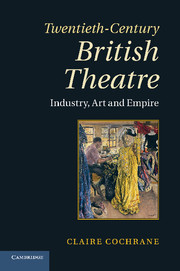Book contents
- Frontmatter
- Contents
- Acknowledgements
- Introduction
- Chapter 1 The topography of theatre in 1900
- Chapter 2 Structures of management
- Chapter 3 The profession of acting
- Chapter 4 The amateur phenomenon
- Chapter 5 The topography of theatre in 1950
- Chapter 6 The business of theatre
- Chapter 7 The changing demographic of performance
- Chapter 8 The topography of theatre in 2000
- Conclusion
- Notes
- Select Bibliography
- Index
Chapter 7 - The changing demographic of performance
Published online by Cambridge University Press: 05 November 2011
- Frontmatter
- Contents
- Acknowledgements
- Introduction
- Chapter 1 The topography of theatre in 1900
- Chapter 2 Structures of management
- Chapter 3 The profession of acting
- Chapter 4 The amateur phenomenon
- Chapter 5 The topography of theatre in 1950
- Chapter 6 The business of theatre
- Chapter 7 The changing demographic of performance
- Chapter 8 The topography of theatre in 2000
- Conclusion
- Notes
- Select Bibliography
- Index
Summary
Demographic change manifests itself in the way the conditions of life in communities change over time. It is experienced both physically and psychologically in movement across particular kinds of community boundaries, be it the imagined communities of specific ethnicities or communities created by socio-economic or political categories and structures. In her discussion of social formations of identity and the power relations which control them, the geographer Cindi Katz has stated that ‘all societies are relational in that they are produced through uneven social relations that create and maintain particular identifications and formations of difference’. ‘Under contemporary conditions,’ she claims, ‘the most formidable sources of power remain capitalist production, patriarchy and racism.’ All three impacted on the way the British theatre community divided and subdivided into different spatial locations and categories of cultural practice throughout the century. Where uneven social relations were renegotiated success or failure often depended on the actions of the ‘knowledge elite’, who both exercise and broker power extending far beyond the actual physical boundaries of where they are located.
In the case of social formations of class which I want to address in the first part of this chapter, I would wish to argue that the social mobility, which produced the phenomenon of the ‘new’ actor, was primarily enabled by opening up access to local spaces of metropolitan power during the 1950s and 60s. It was limited and it was gendered. Women did not achieve the same degree of mobility during this period. Where greater fluidity of access was subsequently achieved was through the medium of television. The spatial effects of this new medium of mass communication could more readily cross social categories. Although spatially controlled within the domestic space, it nevertheless permitted the visual representation of hitherto marginalised ‘other’ communities on a previously unimaginable scale.
- Type
- Chapter
- Information
- Twentieth-Century British TheatreIndustry, Art and Empire, pp. 207 - 238Publisher: Cambridge University PressPrint publication year: 2011



